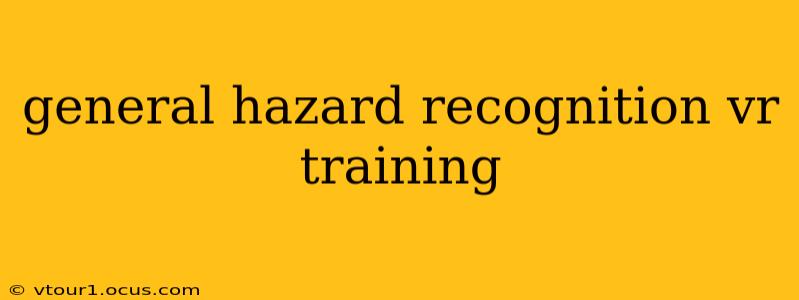The construction industry, like many others, faces significant challenges in effectively training employees on hazard recognition. Traditional methods, such as classroom lectures and on-site demonstrations, often lack the immersive and engaging experience needed for optimal learning and retention. This is where Virtual Reality (VR) training steps in, offering a revolutionary approach to general hazard recognition. VR training simulates real-world scenarios, allowing trainees to identify hazards in a safe, controlled environment before encountering them on the job site.
What is General Hazard Recognition VR Training?
General hazard recognition VR training uses immersive VR technology to create realistic simulations of various work environments. Trainees wear VR headsets and interact with the virtual world, encountering a range of potential hazards. The training focuses on developing the crucial skill of proactively identifying potential risks, fostering a safety-first mindset. Instead of passively listening to lectures, trainees actively participate, making decisions and experiencing the consequences of their actions (or inaction) in a risk-free setting.
Why Choose VR for Hazard Recognition Training?
VR offers several advantages over traditional training methods:
- Increased Engagement and Retention: The immersive nature of VR significantly improves engagement, leading to better knowledge retention compared to passive learning methods.
- Safe and Controlled Environment: Trainees can practice identifying hazards in a risk-free environment, without the potential for real-world injuries or damage.
- Cost-Effective: While the initial investment in VR equipment may be significant, the long-term cost savings from reduced accidents and improved safety performance can be substantial.
- Improved Training Consistency: VR training ensures all employees receive the same high-quality training, eliminating inconsistencies that can occur with traditional methods.
- Personalized Learning: VR can adapt to the individual learner's pace and provide targeted feedback, enhancing the learning experience.
- Realistic Scenarios: VR can simulate a wide variety of work environments and hazard scenarios, making the training more relevant and applicable to real-world situations.
What Types of Hazards are Covered in VR Training?
General hazard recognition VR training programs typically cover a wide range of hazards, including:
- Fall Hazards: Working at heights, slips, trips, and falls on uneven surfaces.
- Electrical Hazards: Exposed wiring, damaged equipment, and working near power lines.
- Fire Hazards: Flammable materials, ignition sources, and emergency procedures.
- Chemical Hazards: Handling hazardous materials, proper use of personal protective equipment (PPE), and emergency response protocols.
- Ergonomic Hazards: Repetitive movements, awkward postures, and improper lifting techniques.
- Machine Hazards: Moving parts, pinch points, and entanglement risks.
- Traffic Hazards: Forklifts, vehicles, and pedestrian safety.
How Effective is VR Hazard Recognition Training?
Studies have shown that VR training can significantly improve hazard recognition skills and safety performance. Trainees who undergo VR training often demonstrate a greater ability to identify hazards and respond appropriately compared to those who receive traditional training. The interactive nature of VR helps solidify learning and improves retention rates.
How Does VR Training Compare to Traditional Methods?
| Feature | VR Training | Traditional Training |
|---|---|---|
| Engagement | High | Low |
| Retention | High | Low |
| Safety | Risk-free environment | Potential for accidents |
| Cost-effectiveness | High long-term cost savings | Potentially high costs due to accidents |
| Consistency | High | Variable |
| Flexibility | Adaptable to individual learning styles | Less adaptable |
What are the Future Trends in VR Hazard Recognition Training?
The future of VR hazard recognition training looks bright. We can expect to see:
- More sophisticated simulations: VR technology is constantly improving, allowing for even more realistic and immersive training experiences.
- Integration with other technologies: VR training will likely be integrated with other technologies, such as augmented reality (AR) and artificial intelligence (AI), to further enhance its effectiveness.
- Wider adoption across industries: As the benefits of VR training become more widely recognized, its adoption across various industries is expected to increase significantly.
In conclusion, general hazard recognition VR training represents a significant advancement in safety education. By offering an engaging, immersive, and effective learning experience, VR training empowers employees to proactively identify and mitigate hazards, fostering a safer work environment for everyone. The cost-effectiveness and improved safety outcomes make it a compelling solution for organizations committed to safety excellence.
